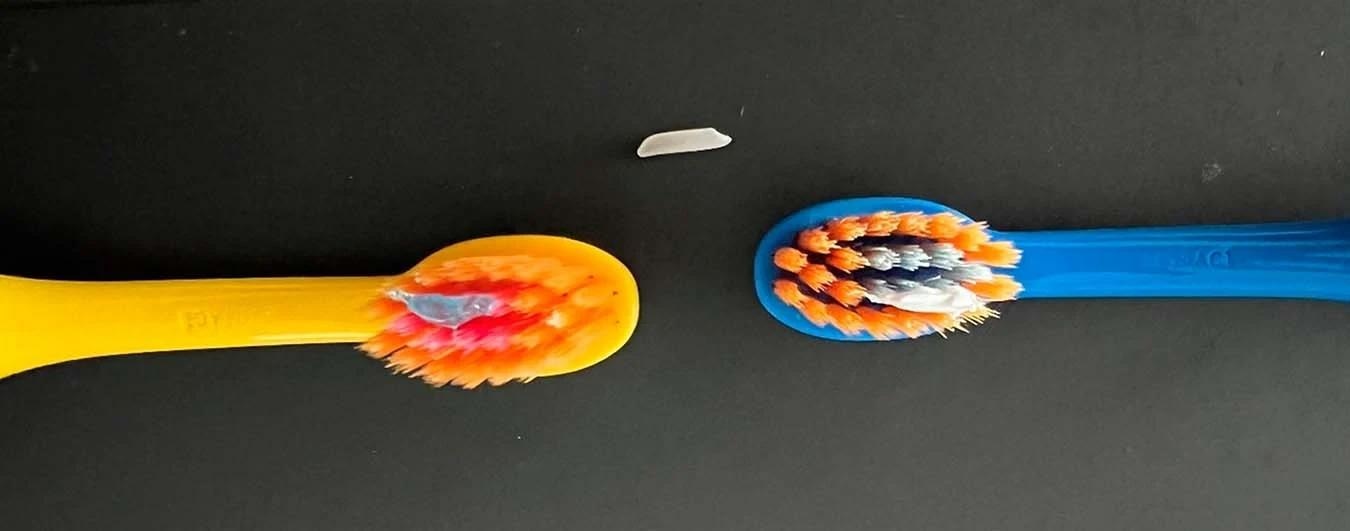While good oral hygiene during childhood is critical to prevent dental caries and other oral diseases, the fluoride present in toothpaste has raised toxicological concerns about its safety for infants and toddlers.
Studies have also observed that despite fluorides being used frequently around the world, dental caries continue to be prevalent, with global estimates suggesting that they affect nearly half of all children.
Fluoride may cause chronic toxicity and other adverse long-term effects. For this reason, guidelines in different parts of the world suggest limiting the dose of fluoride for young children to a small smear or the size of a single grain of rice (up to 24 months of age) or a pea (for children under six).
However, young children may swallow 64-100% of their toothpaste, putting them at risk of dental fluorosis since they are being systematically exposed to fluoride. Therefore, it is crucial to collect more information on how much toothpaste their parents are giving them.
About the study
In this study, researchers hypothesized that parents would find it challenging to follow guidelines recommending giving children aged up to two years one grain’s rice worth of toothpaste. They tested this hypothesis by testing the real-life doses of toothpaste given by parents to their children.
The study was undertaken across five daycare centers in Germany, where parents were given two commercially available brands of toothpaste containing 1,000 ppm of fluoride and suitable for children and asked to dose them as they usually did at home.

Photograph of the reference doses (i.e., a grain of rice-size amount of toothpaste as recommended for toothpastes for children aged up to 24 months with 1000 ppm fluoride) of toothpaste A (left) and toothpaste B (right) on children’s toothbrushes. A natural grain of rice was used as model. Both amounts were dosed by an experienced dentist.
To be included in the study, they needed to use fluoride toothpaste for children at home regularly. Parents of children older than two years were asked to provide a dose based on what they did before the child’s second birthday. This was considered to be representative of how much they would give their children at home.
The weight of each dose was determined and compared with the ‘optimal’ recommendation of one grain. Parents were also asked to state how frequently their child’s teeth were brushed every day to calculate fluoride exposure, as well as their knowledge of the optimal doses.
Findings
The children were, on average, 24 months old at the time of the study, and 61 parents met the inclusion criteria. More than 60% of parents said that their children brushed twice daily, while about 23% said they brushed thrice daily.
The average value of a reference dose of fluoride was 0.039-0.045g; however, parents dosed their children with 0.263-0.281g of fluoride on average. The overdose factor was between 5.6 and 8.2.
More than 60% of parents did not know about fluoride health warnings or conditions for its use. Nearly 15% used fluoride tablets in addition to fluoride toothpaste for their child.
Conclusions
These findings show that children may be receiving overdoses of fluoride from their parents. The authors noted that they may be underestimating children’s exposure to the substance, as fluoride is also present in foods such as rice, cow milk, and bananas, as well as drinking water and sometimes salt.
However, even fluoride intake through toothpaste exceeded what is considered to be an upper limit to avoid dental fluorosis. Further research should undertake a comprehensive risk assessment, including other sources of fluorides, and also consider the possibility of neurotoxicity as an outcome. It should also take socioeconomic factors into account.
One of the reasons for large dose sizes could be that television commercials often showcase excess amounts of toothpaste on brushes. For example, previous studies had shown that most advertisements depicted a large swirl of paste that covered the entire head of the brush, far exceeding the recommended dose. The flavor of toothpaste may also be palatable to children, leading them to ingest more.
Since dispensing a rice grain’s worth of fluoride may be challenging for parents, the researchers suggest using fluoride-free toothpaste varieties, including some other anti-caries substances.
These could include calcium sodium phosphosilicate or hydroxyapatite, of which the latter has been clinically shown to be protective against caries. It is safe for infants and toddlers if swallowed and can reduce bacterial colonization on the surface of teeth. Encouraging parents to replace fluoride toothpaste with efficient and safe alternatives can promote oral care in young children – and keep them safe from fluorosis.
Journal reference:
- Doses of fluoride toothpaste for children up to 24 months. Sudradjat, H., Meyer, F., Fandrich, P., Schulze sur Wiesche, E., Limeback, H., Enax, J. BDJ Open (2024). DOI: 10.1038/s41405-024-00187-7, https://www.nature.com/articles/s41405-024-00187-7